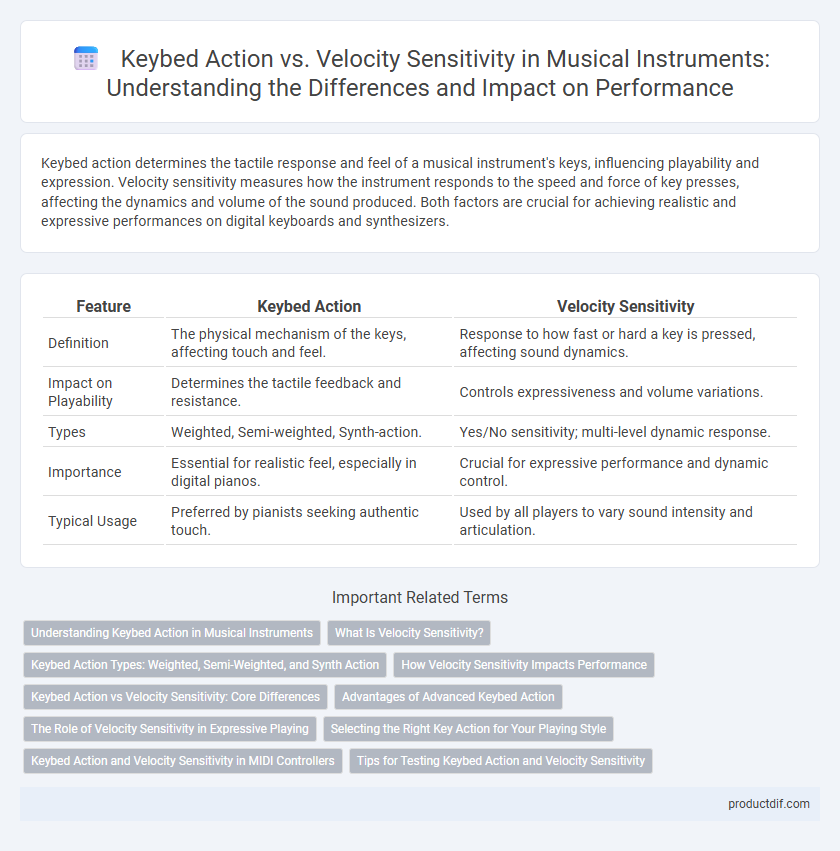Keybed action determines the tactile response and feel of a musical instrument's keys, influencing playability and expression. Velocity sensitivity measures how the instrument responds to the speed and force of key presses, affecting the dynamics and volume of the sound produced. Both factors are crucial for achieving realistic and expressive performances on digital keyboards and synthesizers.
Table of Comparison
| Feature | Keybed Action | Velocity Sensitivity |
|---|---|---|
| Definition | The physical mechanism of the keys, affecting touch and feel. | Response to how fast or hard a key is pressed, affecting sound dynamics. |
| Impact on Playability | Determines the tactile feedback and resistance. | Controls expressiveness and volume variations. |
| Types | Weighted, Semi-weighted, Synth-action. | Yes/No sensitivity; multi-level dynamic response. |
| Importance | Essential for realistic feel, especially in digital pianos. | Crucial for expressive performance and dynamic control. |
| Typical Usage | Preferred by pianists seeking authentic touch. | Used by all players to vary sound intensity and articulation. |
Understanding Keybed Action in Musical Instruments
Keybed action in musical instruments refers to the mechanical and tactile response of the keys when pressed, which significantly influences playability and expression. High-quality keybeds simulate the weighted resistance of acoustic pianos, allowing for dynamic control and nuanced performance. Understanding keybed action is crucial for selecting instruments suited to different playing styles, from synths requiring lighter keybeds to digital pianos demanding authentic hammer action.
What Is Velocity Sensitivity?
Velocity sensitivity in musical instruments refers to the ability of a keyboard or digital piano to detect and respond to the speed or force with which a key is pressed, allowing for dynamic sound expression. This feature captures subtle variations in playing intensity, enabling musicians to produce softer or louder notes naturally. Unlike keybed action, which focuses on the physical feel and resistance of the keys, velocity sensitivity enhances performance expressiveness by translating key strike speed into variable volume and timbre.
Keybed Action Types: Weighted, Semi-Weighted, and Synth Action
Weighted keybed action mimics the feel of an acoustic piano by adding resistance with hammer-like mechanisms, ideal for classical and expressive playing. Semi-weighted keybeds combine spring mechanisms with light weights, offering a balance between speed and control suited for versatile performance styles. Synth action keybeds feature a light, spring-loaded design emphasizing fast response and ease of play, preferred in electronic and synth-heavy music genres.
How Velocity Sensitivity Impacts Performance
Velocity sensitivity in musical instruments directly affects the expressiveness and dynamic range of a performance by translating the speed and force of key presses into varying sound intensities. This capability allows musicians to convey emotion and nuance, making each note more responsive to their touch and enhancing the overall musicality. Keybed action complements velocity sensitivity by providing tactile feedback, but it is the velocity sensitivity that primarily determines the instrument's ability to capture performance subtleties.
Keybed Action vs Velocity Sensitivity: Core Differences
Keybed action refers to the mechanical feel and responsiveness of the keys when pressed, influencing playing comfort and control, whereas velocity sensitivity measures how the instrument detects the speed or force of key presses to vary sound dynamics. High-quality keybeds offer weighted or graded hammer action, mimicking acoustic pianos, while velocity sensitivity allows nuanced expression by tracking input speed for louder or softer tones. Understanding these core differences helps musicians choose instruments that best suit their playing style and expressive needs.
Advantages of Advanced Keybed Action
Advanced keybed action in musical instruments offers superior tactile responsiveness and enhanced dynamic control, allowing musicians to execute nuanced performances with greater precision. This technology improves the realism of playing by mimicking the feel of acoustic piano keys, which elevates expressive potential. Enhanced keybed action also contributes to reduced fatigue during extended sessions, supporting better technique and endurance.
The Role of Velocity Sensitivity in Expressive Playing
Velocity sensitivity plays a crucial role in expressive playing by responding dynamically to the force and speed of a key press, allowing musicians to convey emotion through variations in volume and tone. Unlike keybed action, which primarily affects the tactile response and feel of the keys, velocity sensitivity influences the sonic output, enabling nuanced control over phrasing and articulation. High-quality digital pianos and keyboards incorporate advanced velocity-sensitive sensors to replicate the expressive capabilities of acoustic instruments.
Selecting the Right Key Action for Your Playing Style
Selecting the right keybed action is crucial for matching your playing style, whether you prefer weighted keys that mimic an acoustic piano or lighter synth-action keys for faster, expressive playing. Velocity sensitivity enhances dynamic control by responding to how hard or soft you press the keys, allowing for nuanced performances across genres such as classical, jazz, or electronic music. Prioritize instruments with adjustable keybed action and velocity curves to customize responsiveness and achieve optimal expressiveness tailored to your technique.
Keybed Action and Velocity Sensitivity in MIDI Controllers
Keybed action in MIDI controllers determines the tactile response and feel of the keys, influencing playability and expression during performance. Velocity sensitivity measures how accurately the controller registers the speed and force of key presses, enabling dynamic control over volume and timbre. Combining a responsive keybed action with precise velocity sensitivity enhances realism and emotional nuance in digital music production.
Tips for Testing Keybed Action and Velocity Sensitivity
When testing keybed action, press each key slowly and rapidly to assess weighting and return speed for consistent responsiveness. For velocity sensitivity, use a MIDI controller or digital piano with velocity output to measure dynamic range accuracy and responsiveness to varying pressure. Focus on smooth, even key travel and precise velocity mapping to ensure expressive performance capabilities.
Keybed Action vs Velocity Sensitivity Infographic

 productdif.com
productdif.com